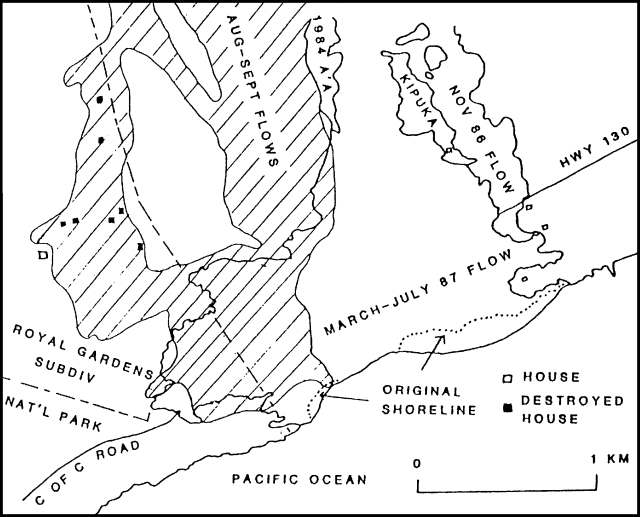Report on Kilauea (United States) — August 1987
Scientific Event Alert Network Bulletin, vol. 12, no. 8 (August 1987)
Managing Editor: Lindsay McClelland.
Kilauea (United States) Lava production continues; deep tremor
Please cite this report as:
Global Volcanism Program, 1987. Report on Kilauea (United States) (McClelland, L., ed.). Scientific Event Alert Network Bulletin, 12:8. Smithsonian Institution. https://doi.org/10.5479/si.GVP.SEAN198708-332010
Kilauea
United States
19.421°N, 155.287°W; summit elev. 1222 m
All times are local (unless otherwise noted)
The low-level eruptive activity . . . continued through August. Lava advanced SE from the vent area through well-developed tubes over the steep slope of a major fault scarp ("pali") threatening only the E end of Royal Gardens Subdivision and covering a small portion of an unused access road. At ~150 m elevation, lava moved slightly W of earlier flows, and by the end of the month the flow front had advanced to ~25 m elevation, 1 km from the ocean. During the first week of September, lava overrode earlier flows that covered Hwy 130, and the most active part of the 200-m-wide flow, along its W margin, had moved to within 100 m of the Chain of Craters Road inside the national park (figure 52). A small lobe was approaching the ocean E of the park, but advance was only sporadic. The level of the lava pond over the vent continued to vary, with a few small, brief overflows onto the shield during the month. Most of the lava emptied from the neck at the SE end of the pond into the tube system.
Harmonic tremor continued at a low level below the shield vent and Pu`u `O`o. Tremor occasionally varied at intervals of a few hours, but generally remained constant for periods of a few days. Bursts of 40-60-km-deep tremor SW of Kīlauea became increasingly frequent during the last half of the month after three weeks of relative quiet. By mid-August, the number of seismic events beneath Pu`u `O`o (structural adjustments after the 26 June conduit collapse event) had declined considerably, from ~200 shallow microshocks/day in July to ~50/day in late August. There were no unusually significant earthquakes in August; eight had magnitudes of 2.5-4.2. Most occurred in persistent seismic source areas 5-10 km deep in the S flanks of Kīlauea and Mauna Loa.
Geological Summary. Kilauea overlaps the E flank of the massive Mauna Loa shield volcano in the island of Hawaii. Eruptions are prominent in Polynesian legends; written documentation since 1820 records frequent summit and flank lava flow eruptions interspersed with periods of long-term lava lake activity at Halemaumau crater in the summit caldera until 1924. The 3 x 5 km caldera was formed in several stages about 1,500 years ago and during the 18th century; eruptions have also originated from the lengthy East and Southwest rift zones, which extend to the ocean in both directions. About 90% of the surface of the basaltic shield volcano is formed of lava flows less than about 1,100 years old; 70% of the surface is younger than 600 years. The long-term eruption from the East rift zone between 1983 and 2018 produced lava flows covering more than 100 km2, destroyed hundreds of houses, and added new coastline.
Information Contacts: C. Heliker and R. Koyanagi, HVO.


